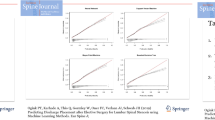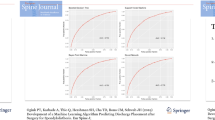Abstract
Purpose
The majority of lumbar spine surgery referrals do not proceed to surgery. Early identification of surgical candidates in the referral process could expedite their care, whilst allowing timelier implementation of non-operative strategies for those who are unlikely to require surgery. By identifying clinical and imaging features associated with progression to surgery in the literature, we aimed to develop a machine learning model able to mirror surgical decision-making and calculate the chance of surgery based on the identified features.
Material and methods
In total, 55 factors were identified to predict surgical progression. All patients presenting with a lumbar spine complaint between 2013 and 2019 at a single Australian Tertiary Hospital (n = 483) had their medical records reviewed and relevant data collected. An Artificial Neural Network (ANN) was constructed to predict surgical candidacy. The model was evaluated on its accuracy, discrimination, and calibration.
Results
Eight clinical and imaging predictive variables were included in the final model. The ANN was able to predict surgical progression with 92.1% accuracy. It also exhibited excellent discriminative ability (AUC = 0.90), with good fit of data (Calibration slope 0.938, Calibration intercept – 0.379, HLT > 0.05).
Conclusion
Through use of machine learning techniques, we were able to model surgical decision-making with a high degree of accuracy. By demonstrating that the operating patterns of single centres can be modelled successfully, the potential for more targeted and tailored referrals becomes possible, reducing outpatient wait-list duration and increasing surgical conversion rates.



Similar content being viewed by others
Data availability
Available at request.
Code availability
SPSS is a publicly available software. The final model is not currently available for public use given current ongoing validation.
References
Yavin D, Casha S, Wiebe S, Feasby TE, Clark C, Isaacs A, Holroyd-Leduc J, Hurlbert RJ, Quan H, Nataraj A (2017) Lumbar fusion for degenerative disease: a systematic review and meta-analysis. Neurosurgery 80:701–715
Senders JT, Staples PC, Karhade AV, Zaki MM, Gormley WB, Broekman ML, Smith TR, Arnaout O (2018) Machine learning and neurosurgical outcome prediction: a systematic review. World Neurosurg 109:476–486
Collins GS, Reitsma JB, Altman DG, Moons KG (2015) Transparent reporting of a multivariable prediction model for individual prognosis or diagnosis (TRIPOD): the TRIPOD statement. BMC Med 13:1
Moons KG, Altman DG, Reitsma JB, Ioannidis JP, Macaskill P, Steyerberg EW, Vickers AJ, Ransohoff DF, Collins GS (2015) Transparent reporting of a multivariable prediction model for individual prognosis or diagnosis (TRIPOD): explanation and elaboration. Ann Intern Med 162:W1–W73
Jain AK, Mao J, Mohiuddin KM (1996) Artificial neural networks: A tutorial. Computer 29:31–44
Azimi P, Benzel EC, Shahzadi S, Azhari S, Mohammadi HR (2014) Use of artificial neural networks to predict surgical satisfaction in patients with lumbar spinal canal stenosis. J Neurosurg Spine 20:300–305
Azimi P, Benzel EC, Shahzadi S, Azhari S, Mohammadi HR (2016) The prediction of successful surgery outcome in lumbar disc herniation based on artificial neural networks. J Neurosurg Sci 60:173–177
Azimi P, Mohammadi HR, Benzel EC, Shahzadi S, Azhari S (2015) Use of artificial neural networks to predict recurrent lumbar disk herniation. J Spinal Disord Tech 28:E161-165. https://doi.org/10.1097/BSD.0000000000000200
Babaee M, Soleimani P, Zali A, Kabir NM, Chizari M (2018) A Predictive model for assessment of successful outcome in posterior spinal fusion surgery. Int Clin Neurosci J 4:143–151
Hosmer DW Jr, Lemeshow S, Sturdivant RX (2013) Applied logistic regression. Wiley
van Dongen JM, van Hooff ML, Spruit M, de Kleuver M, Ostelo RWJG (2017) Which patient-reported factors predict referral to spinal surgery? A cohort study among 4987 chronic low back pain patients. Eur Spine J 26:2782–2788. https://doi.org/10.1007/s00586-017-5201-9
Willems P, de Bie R, Öner C, Castelein R, de Kleuver M (2011) Clinical decision making in spinal fusion for chronic low back pain. results of a nationwide survey among spine surgeons. BMJ Open 1:000391
Pearse E, Maclean A, Ricketts D (2006) The extended scope physiotherapist in orthopaedic out-patients–an audit. Annal R Coll Surg England 88:653–655
Wilgenbusch CS, Wu AS, Fourney DR (2014) Triage of spine surgery referrals through a multidisciplinary care pathway: a value-based comparison with conventional referral processes. Spine 39:S129–S135
Blackburn MS, Nall C, Cary B, Cowan SM (2009) Physiotherapy-led triage clinic for low back pain. Aust Health Rev 33:663–670
Simon D, Coyle M, Dagenais S, O’neil J, Wai EK, (2009) Potential triaging of referrals for lumbar spinal surgery consultation: a comparison of referral accuracy from pain specialists, findings from advanced imaging and a 3-item questionnaire. Can J Surg 52:473
Huang JG, Huang GH, Teddy PJ (2008) Low back pain in neurosurgical outpatients: an audit. J Clin Neurosci 15:1216–1221
Vroomen P, De Krom M, Wilmink J, Kester A, Knottnerus J (2002) Diagnostic value of history and physical examination in patients suspected of lumbosacral nerve root compression. J Neurol Neurosurg Psych 72:630–634
Janardhana AP, Rajagopal SR, Kamath A (2010) Correlation between clinical features and magnetic resonance imaging findings in lumbar disc prolapse. Ind J Orthopae 44:263
Bardin LD, King P, Maher CG (2017) Diagnostic triage for low back pain: a practical approach for primary care. Med J Aust 206:268–273
Rushton A, Zoulas K, Powell A, Staal JB (2018) Physical prognostic factors predicting outcome following lumbar discectomy surgery: systematic review and narrative synthesis. BMC Musculoskelet Disord 19:326
McGirt MJ, Bydon M, Archer KR, Devin CJ, Chotai S, Parker SL, Nian H, Harrell FE Jr, Speroff T, Dittus RS (2017) An analysis from the quality outcomes database, part 1. disability, quality of life, and pain outcomes following lumbar spine surgery: predicting likely individual patient outcomes for shared decision-making. J Neurosurg Spine 27:357–369
McGirt MJ, Sivaganesan A, Asher AL, Devin CJ (2015) Prediction model for outcome after low-back surgery: individualized likelihood of complication, hospital readmission, return to work, and 12-month improvement in functional disability. Neurosurg Focus 39:E13
Cheng F, You J, Rampersaud YR (2010) Relationship between spinal magnetic resonance imaging findings and candidacy for spinal surgery. Can Fam Phys 56:e323–e330
Sterne JA, White IR, Carlin JB, Spratt M, Royston P, Kenward MG, Wood AM, Carpenter JR (2009) Multiple imputation for missing data in epidemiological and clinical research: potential and pitfalls. Bmj 338:2393
Funding
No funding was received for conducting this study.
Author information
Authors and Affiliations
Contributions
All authors made substantial contributions to the work, including conception, design, acquisition, and analysis of data. NX drafted the work, PW and RR were involved in critical revision. All authors approved the final version for submission.
Corresponding author
Ethics declarations
Conflict of interest
The authors have no relevant financial or non-financial interests to disclose.
Ethical approval
Obtained from SESLHD Ethics Committee—approval number 18/035.
Additional information
Publisher's Note
Springer Nature remains neutral with regard to jurisdictional claims in published maps and institutional affiliations.
Supplementary Information
Below is the link to the electronic supplementary material.
Rights and permissions
About this article
Cite this article
Xie, N., Wilson, P.J. & Reddy, R. Use of machine learning to model surgical decision-making in lumbar spine surgery. Eur Spine J 31, 2000–2006 (2022). https://doi.org/10.1007/s00586-021-07104-8
Received:
Revised:
Accepted:
Published:
Issue Date:
DOI: https://doi.org/10.1007/s00586-021-07104-8




